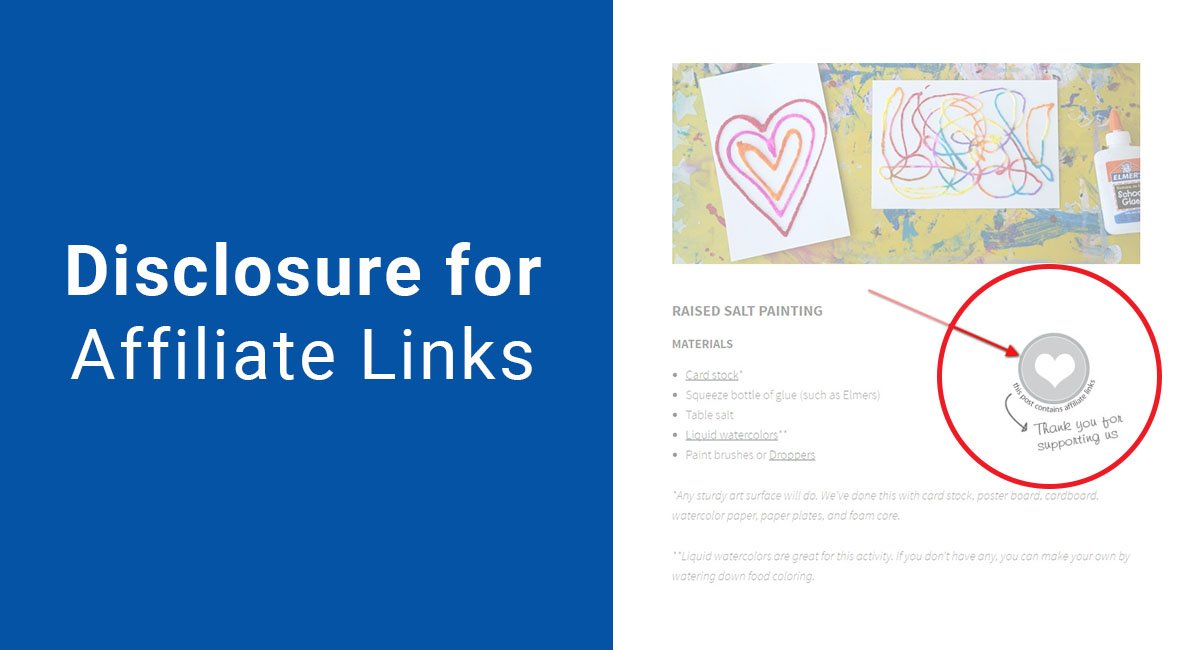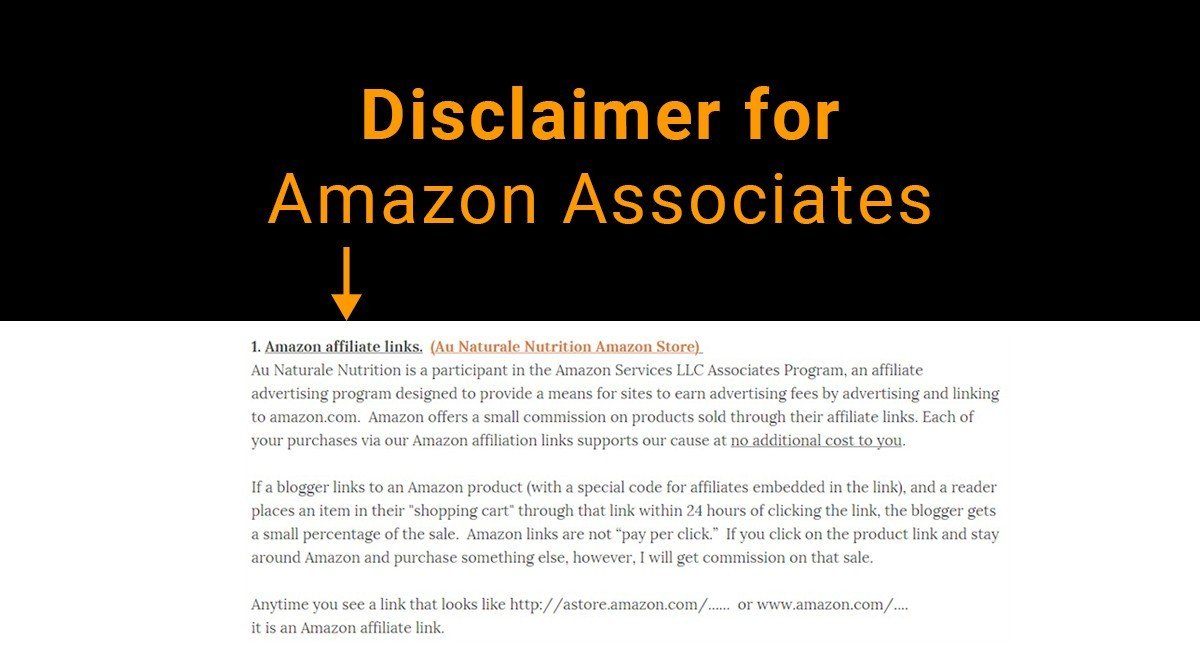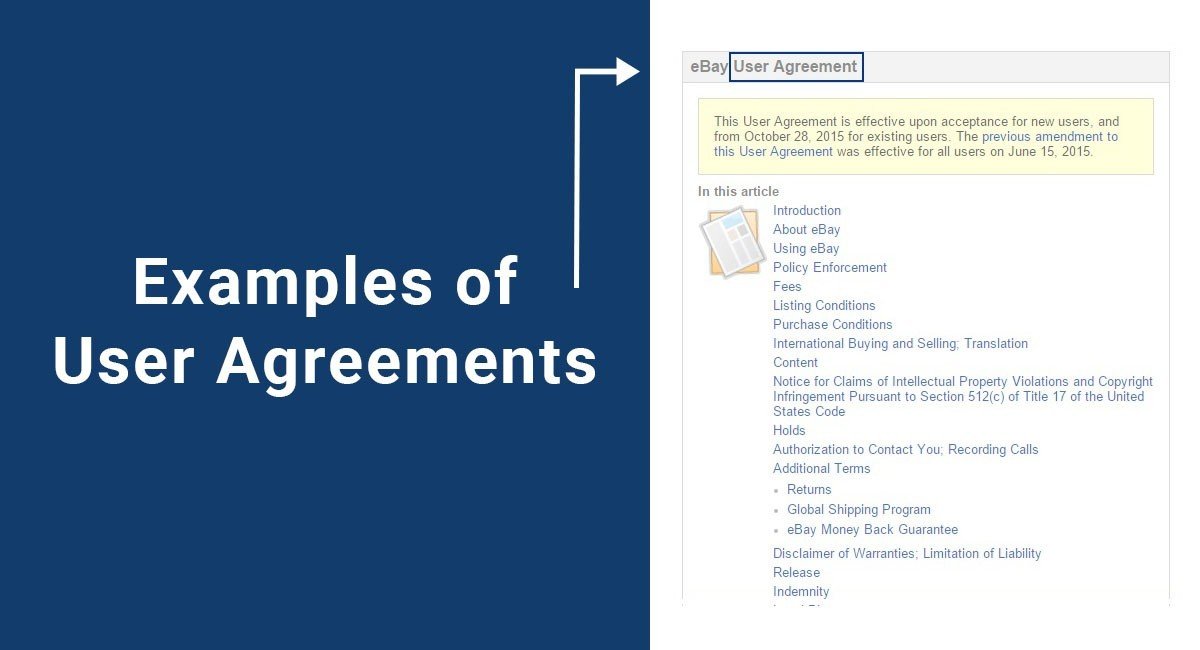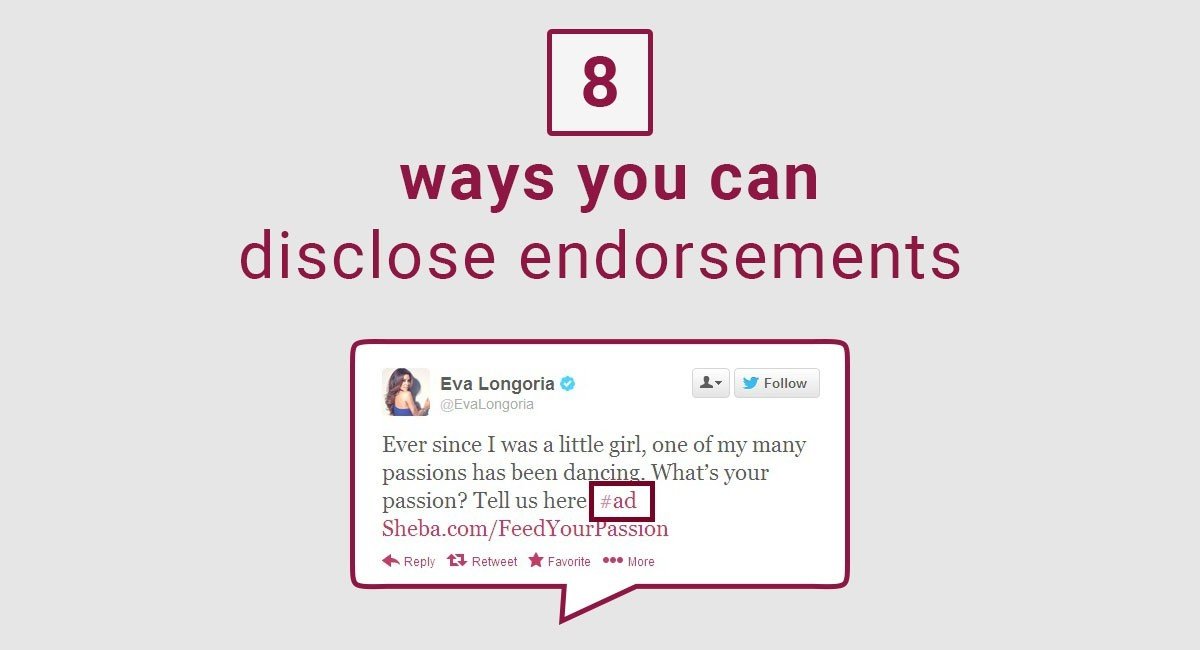A disclosure for your website or blog is a statement that informs your users about something of relevance to them so that they can make informed decisions.
It's basically like the fine print that gives users additional information that they would want or need to know.
There are a number of different disclosures that your website may need, such as a disclaimer for websites that use affiliate links (for example Amazon Associates) and have affiliate relationships with products being sold or recommended to users to purchase.
In the US, if you use affiliate links on your website, you're required by the FTC (Federal Trade Commission) to disclose this.
Back in 2009, the FTC started releasing guidelines for websites that use affiliate links. These guidelines and the affiliate disclosure requirement are an attempt by the FTC to protect consumers by letting them know that any endorsements or product recommendations they're relying on come with a potential financial gain to the website doing the recommending and endorsing.

Since 2009, the FTC has released its Dot Com Disclosures guidelines in 2013, and an updated website for "What People Are Asking" in 2015.
These documents address how endorsements, reviews, sponsored posts and influencer online campaigns should be handled when it comes to disclaimers and notices to the public about affiliate relationships.
It's all about clarity and transparency for your users so they can make the most informed decisions of what to buy. Basically, if you stand to make money or receive any sort of benefit - financial or otherwise - from your recommendation or endorsement of a product or service, you must disclose this to the public.
Only a few paragraphs in the "What People Are Asking" document by the FTC specifically address affiliate marketing, but it's thorough enough that affiliate marketers have direction on what they need to do when it comes to disclosing their affiliate relationships.
A disclosure must be:
- Clear and conspicuous, and
- Located as close to the affiliate links or recommendations as possible (not buried on an About Us page)

Even if you aren't in the US, which means you're technically outside of the jurisdiction of the FTC, you still may be required to include affiliate disclosures.
Say, for example, that your non-US-based website is endorsing, recommending or profiting from a company that's based in the US. The FTC may have jurisdiction over you if it receives a number of complaints about your practices being misleading to US citizens.
Third Party Disclosure Requirements
Beyond the FTC requirement for a disclosure on affiliate links, a lot of third party affiliate marketing platforms require it as well for people who participate in the affiliate program.

Amazon Associates, for example, is an online affiliate marketing program that lets website owners earn referral fees.
To earn a referral fee, a website owner will place links to products for sale on Amazon on their own websites. When someone clicks these links via the blogger's website, the blogger will earn a commission.
Section 5 of the Associates Program Operating Agreement is called "Identifying Yourself as an Associate." In this section, Amazon requires that anyone involved in this affiliate program -
"clearly state the following on your site or any other location where Amazon may authorize your display or other use of Content: "We are a participant in the Amazon Services LLC Associates Program, an affiliate advertising program designed to provide a means for us to earn fees by linking to Amazon.com and affiliated sites."
Here's how it looks:

Here's how Ultimate IT Guys created their simple Amazon Associates affiliate program disclosure:
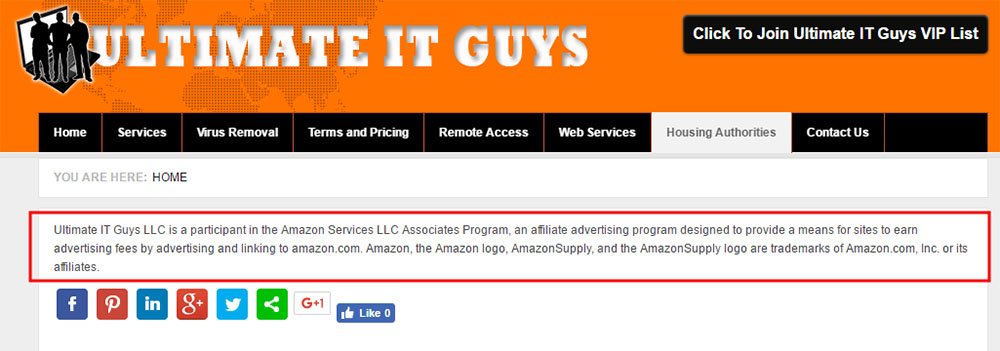
Having affiliate disclosures is also great for relationship-building and earning the trust of your users. Even if this kind of disclosure wasn't required, letting people know you may gain some profit from them right up front makes you seem honest, trustworthy and transparent.
Your users will love this and be happy to help pass on some profit to you for being so straightforward with them about your affiliate program.
The best way to disclose your affiliate relationships is through an affiliate disclosure.
Requirements of an Affiliate Disclosure
An affiliate disclosure has a few requirements:
- It must be clearly and conspicuously placed so that it is easy for users to notice,
- It must be placed close to the "triggering item" such as the affiliate links themselves,
- It must not be buried in graphics, text or other items that make it less noticeable and difficult to see, and
- The language of the disclaimer itself must be clear and understandable to your users
How to Write an Affiliate Disclosure
Here are a few steps and key points to help you create and place your affiliate disclosure.
What to include in the affiliate disclosure
When writing your disclosure, you need to include the following point of information: that you receive compensation for your reviews, recommendations, affiliate links and/or any other method of influencing you do that results in you obtaining a benefit.
Remember, the benefit doesn't have to be monetary but can be anything of worth such as free web-hosting, free products, vacation perks, etc.
Here's an example from iPage that shows a clear disclosure followed by an unclear one.
Note how the top example of a clear disclosure lets users know in simple terms that they receive compensation from the companies whose products they review. Contrasting to this is the second example that says they may receive consideration, but are "totally unbiased and do not accept paid reviews."
It's not entirely clear what the second disclosure is saying when it comes to what they receive and when.
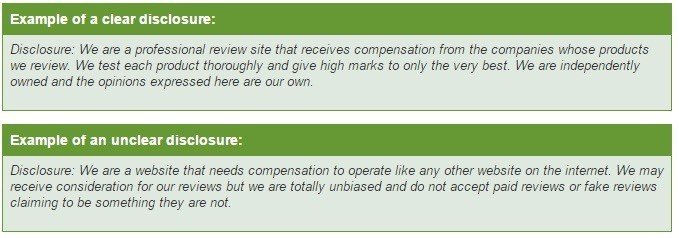
Your affiliate disclosure can be short or long, but remember that clarity is key here so you don't need to say more than you need to.
Keeping your disclosure short and simple will help your users understand what you're saying without confusing things. However, creating a longer disclosure can also help earn trust with your users and show more of your personality.
Here's a short, cute disclosure from NomNomPaleo that covers all the necessary information in a fun cartoon.

Contrast that with this extensive disclaimer by Smart Passive Income:
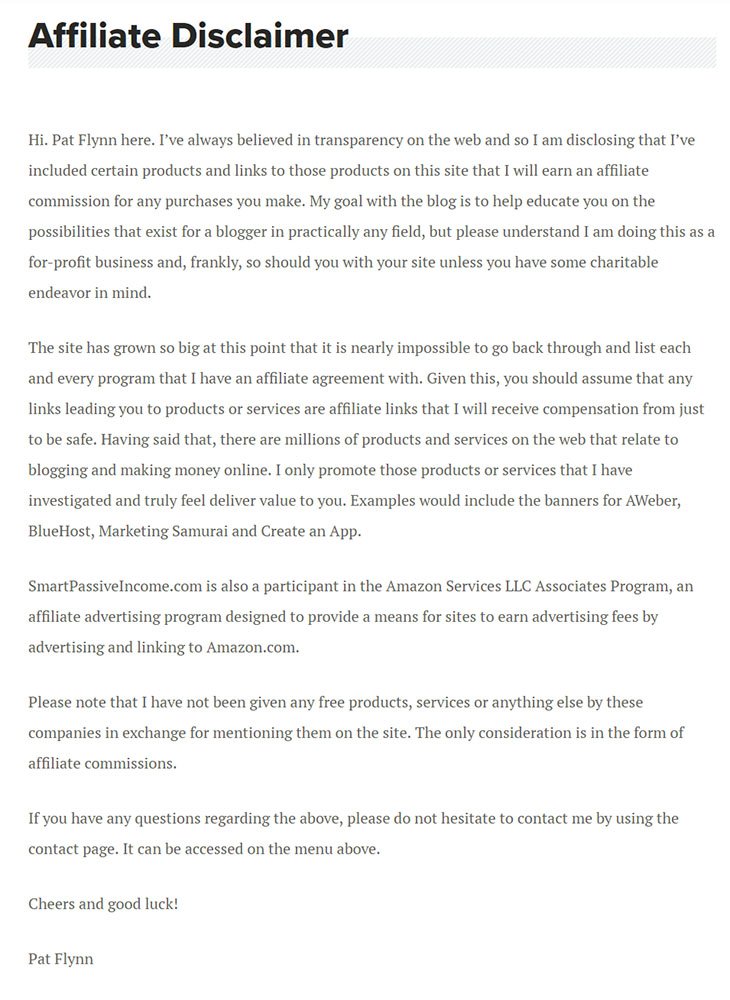
Note that the long disclosure located on its own page isn't adequate enough as the only affiliate disclosure on a website.
A longer disclosure only works if there's also a smaller disclosure located on each post that has affiliate links, and if this smaller disclosure links to the longer standalone disclosure page. Users could easily notice the smaller disclosure in each post, which meets the clear and conspicuous requirements.
You can always create a simple disclosure like the cartoon example from the NomNomPaleo website above that's easy to place on individual web pages and blog posts, then have it link to a full page disclosure page to provide more information to your users.
How to format the affiliate disclosure
Your disclosure must stand out on your website.
At the very least, it must not blend in or be toned down to stand out less than the rest of the website. This can be accomplished through formatting as well as placement.
For formatting, your disclosure must be in a font that's not smaller or in an off color from the rest of the website font, unless the color makes it stand out more.
Here's how a weight-loss website uses background colors, font colors and font sizes to make a very conspicuous affiliate disclosure. You don't have to use bright colors and big font if you don't want to, but you can't use a font color that's difficult to notice or that blends in with the background, or a super small font that's hard to see.
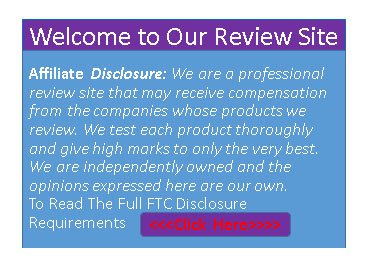
Where to place the affiliate disclosure
After you've written and formatted the text of your affiliate disclosure, where you place it is just as important if not more important than what your disclosure says.
The placement of your disclosure must be clear and conspicuous, meaning it must be:
- Placed close to the triggering items so that a user can logically and easily notice the disclosure while reading your review, endorsement, etc.
- Placed on every single page that has a review, endorsement, etc.
- Not require a user to scroll down to find it, especially if your affiliate links are accessible without scrolling. This would mean that a user could see your links and click on them without even having a chance to notice your disclosure.
Putting one disclosure on an "About Us" or "Info" page and then creating a hyperlink to it from your review or endorsement pages isn't good enough.
The disclosure itself must actually be readable from the page where the endorsement itself is located. You can create a more thorough, lengthy affiliate disclosure and put it on its own separate page, but this can't be the only way your disclosure is made available to your users. It's not clear and conspicuous enough.
Just a Girl and Her Blog places a short but easily-noticeable piece of text on every blog post, directly underneath the title and main image. This placement is perfect because aside from the title of the post, the affiliate link disclosure text will be the first thing a user sees.
A link is provided to her full disclosure, but users are put on alert that there is some sort of affiliate relationship in place:
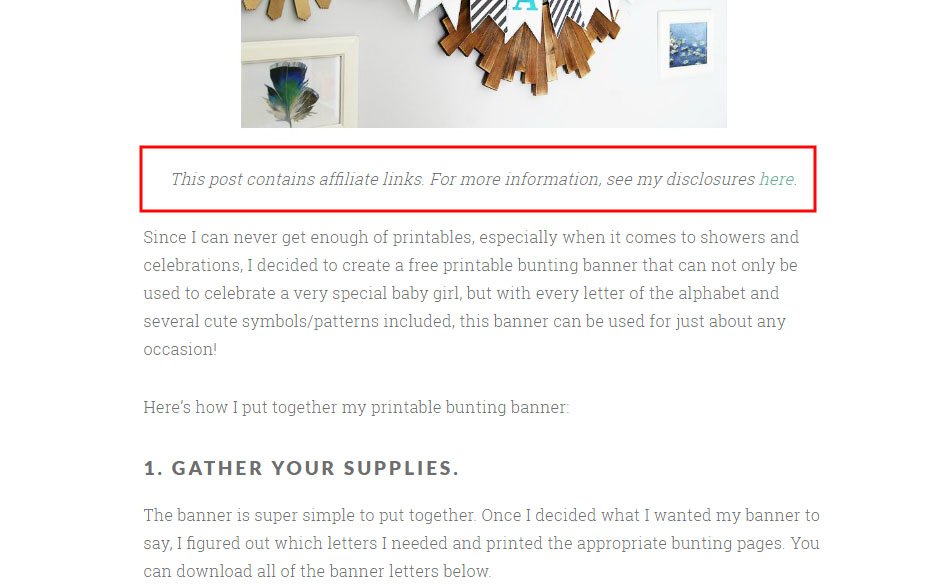
Danya Banya's blog includes a small heart icon at the top of every blog post that has affiliate links. This heart stands out from the rest of the page really well and catches a reader's eye.
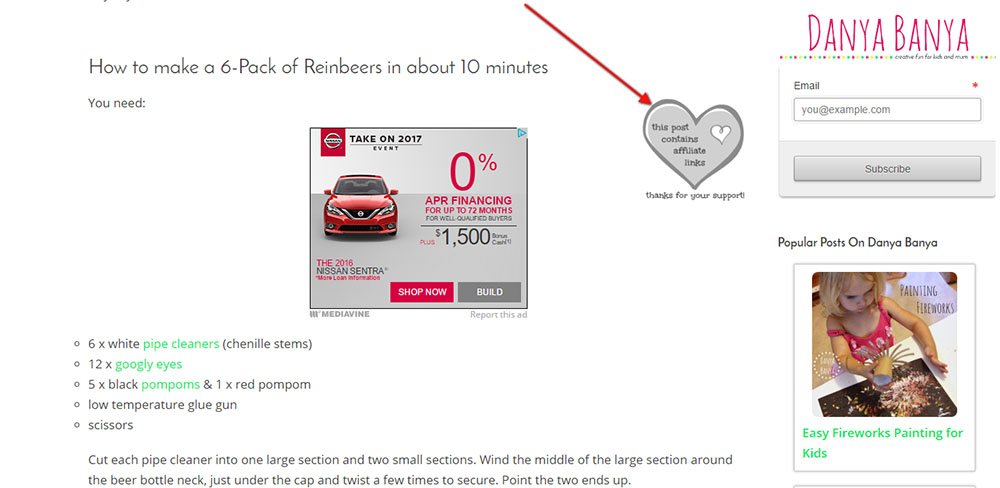
This heart icon on its own isn't informative enough for users since it doesn't explain what affiliate links are.
That's why Danya Banya includes another small disclosure at the bottom of the post that lets users know that she may earn advertising and referral fees if something is purchased through her links, and that this occurs with no extra cost to the users.
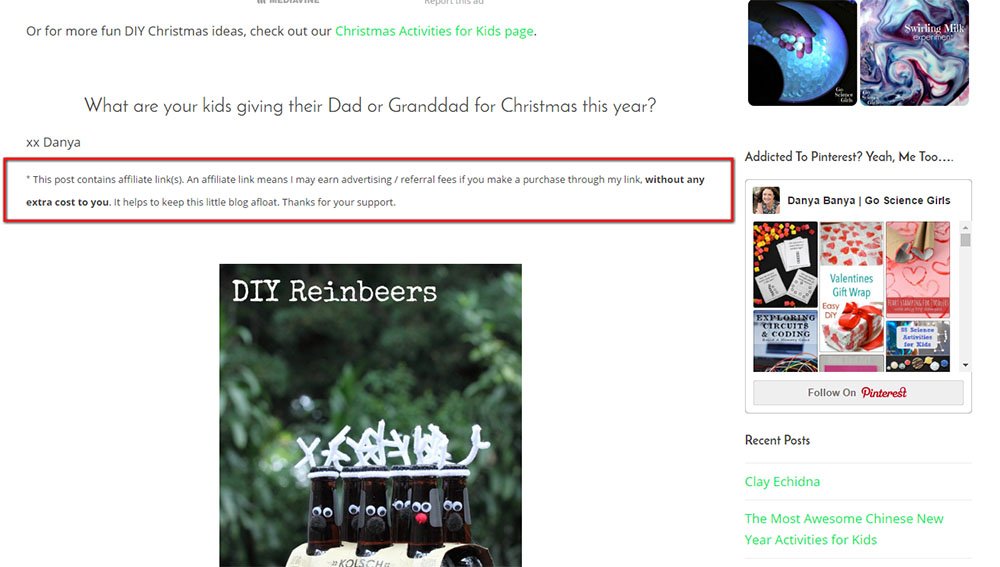
Here's how A Relaxed Gal includes her affiliate disclosure. It's located at the very top of her posts so you can notice it easily. She links her full disclosure to the short notice so that users can find out more information easily.
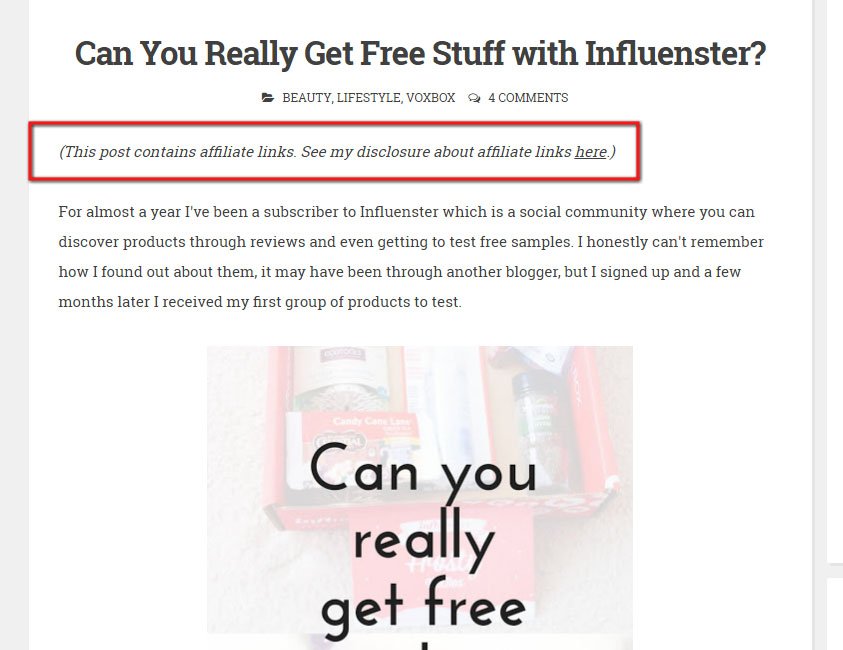
When you click to read her disclosure, that's where you find out the specifics that her blog accepts paid insertions, cash advertising, sponsorship and other forms of compensation.
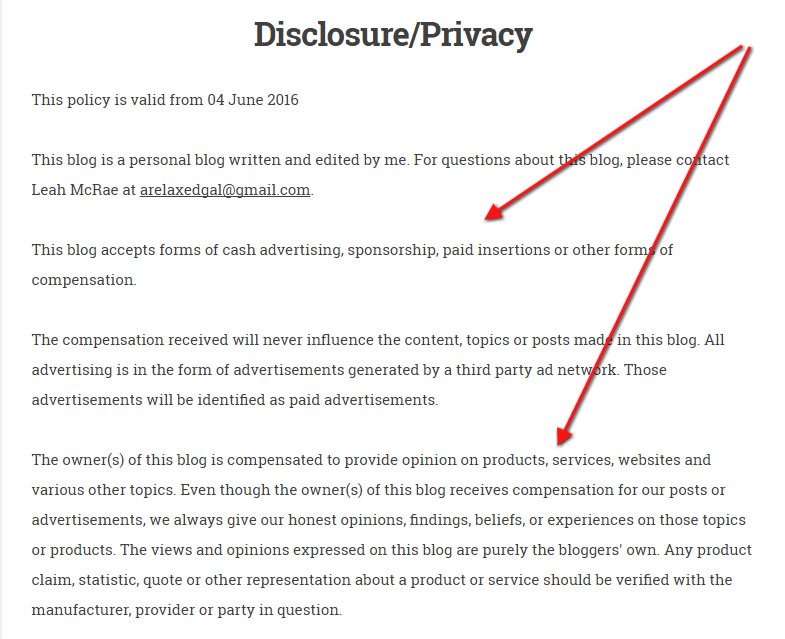
If you receive any form of compensation for affiliate links or relationships on your website or blog, you need to:
- Write a clear and conspicuous affiliate disclosure that lets your users know about this compensation, and
- Place this disclosure in a clear and conspicuous way on your website.
This will keep you compliant with the FTC, with third-party affiliate programs, and will help earn trust of your users by being transparent and open about any financial gains from your blog.

Comprehensive compliance starts with a Privacy Policy.
Comply with the law with our agreements, policies, and consent banners. Everything is included.
